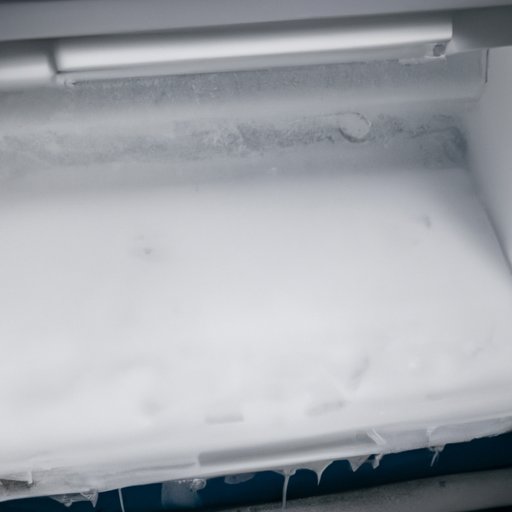
Introduction
Defrosting a freezer can be a hassle, but it’s an important part of freezer maintenance that’s necessary to keep your appliance running efficiently. If you don’t defrost your freezer regularly, you may experience issues like increased energy consumption, frost buildup, and difficulty opening and closing the door. In this article, we’ll provide you with a step-by-step guide to defrosting your freezer safely and effectively.
Step-by-Step Guide
Before you get started, make sure you have all the necessary tools, including towels, a plastic scraper, a bucket, and gloves to protect your hands. Depending on how much ice buildup you have, the defrosting process can take anywhere from a few hours to a full day.
The first step is to unplug the freezer to avoid any electrical hazards. Next, empty out your freezer and transfer the food to a cooler or another freezer. Place towels around the freezer to catch any water that drips down during the defrosting process. Now you’re ready to start removing the ice buildup with a plastic scraper. Be sure to work slowly and carefully to avoid damaging the freezer walls or cooling coils.
Aim the scraper at the thickest parts of the ice buildup and gently push side to side. Once you’ve removed all the visible ice, use a towel to wipe away any remaining water or ice crystals. If necessary, you can also use warm water to help melt stubborn areas of ice.
Once all the ice is removed and the freezer is completely dry, you can plug it back in and return your food items. It’s important to wait until the freezer has reached its target temperature before restocking it with food.
Video Tutorial
To accompany this article, we’ve created a video tutorial that walks you through the steps of defrosting a freezer. The tutorial covers everything outlined in this article and provides a helpful visual guide. We encourage you to watch it before getting started on your own defrosting process.
Common Mistakes
One common mistake people often make when defrosting their freezer is using sharp objects to scrape away ice. This can be dangerous and can cause damage to the freezer’s walls or cooling coils. It’s best to use a plastic scraper or even a spoon instead. Another mistake is not emptying the freezer beforehand, which makes the defrosting process more difficult and time-consuming. Always remove and transfer your food items before beginning the defrosting process.
To avoid these mistakes, take the time to prepare properly by ensuring you have all necessary equipment and emptying the freezer before starting the defrosting process.
Alternative Methods
If you’re in a hurry or have a small freezer with minimal ice buildup, you may be able to use some alternative methods for defrosting your freezer. One option is to use a hair dryer on a low heat setting to melt the ice. Alternatively, you can place bowls of hot water inside the freezer and close the door, allowing the heat and humidity to help melt the ice. However, these methods are not recommended for larger freezers or more significant ice buildup.
Remember to always take precautionary measures when using any method to defrost your freezer. This may include wearing gloves and safety goggles, and keeping the area well-ventilated.
Maintenance Advice
To avoid having to defrost your freezer as frequently in the future, it’s important to take care of your appliance properly. Check the door seal regularly to make sure there are no gaps where cold air can escape. Avoid overfilling the freezer, as this can impede airflow and lead to frost buildup. Finally, be sure to clean out any old or expired food items regularly to keep your freezer tidy and organized.
Dos and Don’ts
Here’s a list of dos and don’ts to follow when defrosting your freezer:
- Do wear gloves and safety goggles to protect yourself
- Do use a plastic scraper or spoon to remove ice buildup
- Do empty the freezer beforehand
- Don’t use sharp objects to remove ice
- Don’t rush the defrosting process; take your time to avoid damaging the freezer
Additional tips include making sure the freezer is completely dry before plugging it back in, and waiting until it has reached its target temperature before returning food items to the freezer.
Conclusion
Defrosting your freezer is an important part of appliance maintenance that can save you time, energy, and money in the long run. By following the steps outlined in this article, you can defrost your freezer safely and effectively. Remember to take care of your freezer properly to avoid having to defrost it as often, and always follow precautionary measures when defrosting or using alternative methods.




